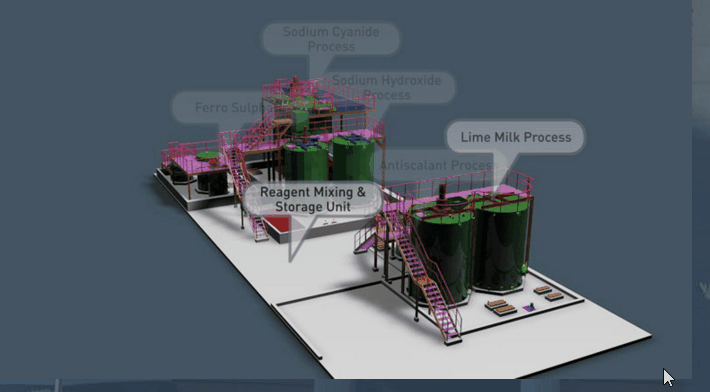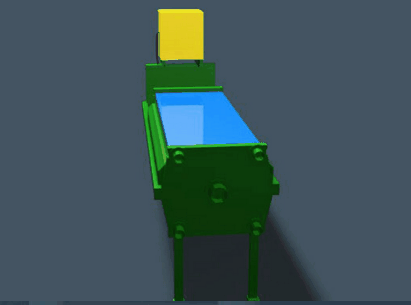Table of Contents
The upgrading of gravity concentrate for smelting purposes by use of intensive cyanidation is still in the experimental stage. It involves the leaching out of the gold into solution, using a strong cyanide mix, and then the electrowinning of that solution so as to recover the gold on the steel wool cathodes. This system is capable of handling all of the initial concentrate off the Wilfley table. Because of physical limitations of the present “pilot plant* it is necessary that the concentrate cut off the Wilfley be limited to 100 kilos every twenty four hours, this being the optimum amount that can be treated efficiently in the leaching vessel. Hence it is necessary for the table to be monitored on a regular basis so as to ensure that not too much gangue gets into the concentrate.
Description of the Intensive Cyanidation Plant
The Leach Vessel (See Fig. 16)
This vessel has a capacity of 0.75 cubic metres. It is fitted with an air sparge and an air operated agitator that has two sets of blades, one set located near the bottom of the vessel and the other midway in the optimum charge. The vessel is also fitted with baffles and the floor is sloped towards the 50 mm dump valve. A 25 mm decant valve is located 230 mm from the base of the container.
The Filtration System
The loaded product from the leach vessel is drawn through the decant valve into a primary bag filter (75 microns) and then pumped through a secondary bag filter (1 micron), this removing most of the foreign material before the solution enters the holding vessel.
The Holding Vessel
This vessel is identical to the leach vessel but it has no baffles in it and it is not agitated. It allows the accurate measurement of the loaded leach and rinse solutions and also acts as a storage vessel should it not be convenient to pump the solutions into the eluate tank. Solutions from the holding vessel may be either gravity fed directly into the eluate tank or pumped to it via the filtration system.
Operation of the Plant
Charging the Leach Vessel
- Fill the vessel with potable water to the 300 litre mark.
- Add 6 kg of NaCN and agitate for around 15 minutes.
- Put in the concentrate – around 100 kgs.
- If necessary add NaOH to attain a pH level of >11.
- Note the level of the solution on the vessel. Fill to the same level when putting in subsequent leach and rinse solutions.
- Start the agitator.
- Adjust the air sparge to 10 kPa.
Optimum Treatment Time
The duration of each leach and the number of leaches required depends largely upon the quality of the concentrate being treated. The first leach solution loads up very quickly and it is advisable to change it after no more than three hours operation. Hence if a charge is put into the leach vessel late in the morning it should be changed mid afternoon and the final leach left in overnight. Generally only two leaches are necessary with the present plant.
Rinsing and Further Leaching
- Stop the agitator and allow the solution to settle.
- Decant through the filtration system into the holding vessel.
- Note the level on the holding vessel and record it on the log sheet.
- Take a sample and filter it. 150 mls to go to the laboratory for assaying; and the pH and cyanide levels to be recorded on the log sheet.
- Fill the leach vessel up to the original mark and agitate the solution for 15 minutes.
- Check to see what stage the current electrowinning is at. If OK pump the holding tank out through the filtration system, into the eluate tank.
- Stop the leach vessel agitator and shut off the air sparge. After settling, pump the solution into the holding vessel. Take a sample for assaying.
- Fill the leach vessel up again as per section “Charging the Leach Vessel” but do not put any additional concentrate in and only use 4 kg of NaCN. Check to see that the pH level is >11.
- The leach and rinse procedures outlined above are to be repeated for the desired number of times. Always be sure to take a sample of both leach and rinse solutions. and to record the quantities of each, and the pH and cyanide levels of leach solutions.
One rinse must be done between leaches and two rinses done after the final leach.
Dumping of Barren Concentrate
- Open the 50 mm dump valve on the leach vessel. This allows the barren material to go back over the Wilfley table and ensures that any coarse gold, that has not been completely dissolved in the leach vessel, will not be able to escape directly back into the circuit.
- Hose out the vessel and then close the valve.
Points to Remember
- For bullion accounting purposes accurate recording is essential. Make sure that the following are completed:
(i) Record the quantity of each leach solution.
(ii) Record the quantity of each rinse solution.
(iii) Take a sample of every leach and rinse solution for assaying.
- Record the amount of reagents used for each leach.
- Record the operating times.
- Close the valves after each transfer from either the leach or holding vessel.
- Check to see that it is OK before pumping out the ‘ holding tank.

- When there is no strip in progress, fill the eluate tank with at least 15 cubic metres of hot water from the elution column before starting up the electrowinning cell. This aids the electrowinning process and also helps to ensure that any sludge that may have settled on the bottom of the eluate tank is not disturbed.
- Check out the filter bags regularly. It is imperative that no solids be allowed to enter the eluate tank.
- Cyanide and Caustic are very dangerous! Always wear gloves and safety glasses when working near the plant. The fume exhaust fan should be left operating at all times.
- Should there be a power failure during an intensive cyanidation process, only go near the plant if it is absolutely necessary and make sure that you are wearing an appropriate mask, i.e. one that is fitted with a cartridge filter suitable for use in cyanide fumes. Remember that there is no water for washing in during a power failure.
- The pilot plant is located almost directly over the barring furnace. Absolute care must be taken when handling fluids so as to ensure that they don’t splash or seep on to the ground floor.
Further Considerations
Within the constraints offered by the physical inadequacies of the present leaching vessel, it can be asserted that “intensive cyanidation* is a feasible alternative to the “acid digesting’ of gravity concentrate. However problems are occurring as a result of the input of intensive cyanidation product into the electrowinning system. The cathodes are being clogged up with precipitate and at the time of printing this manual, two cells were in operation instead of the normal one and all of the cathodes were being changed at least twice a week. In the past it has been possible to load at least 70 kgs. of gold on to one lot of cathodes in a single cell, i.e. nine cathodes, with no ill effects upon the operation of that cell.
This problem will have to be overcome as at present too much additional handling of cathodes and cleaning up of sludge build up within cells is necessary. In addition the subsequent acid digestion and rinsing of loaded wool is made difficult by its sludgy nature. Great care is required in order to prevent loss of product back into the C. I.L. circuit.
Obviously the benefits of being able to forward the loaded solution from intensive cyanidation to the electrowinning system are great in terms of both cost and labour savings. Less strips are required each week and this results in substantial cutbacks in the use of reagents, water and gas; and if the present electrowinning problems are overcome, a high grade product for smelting is ensured.
